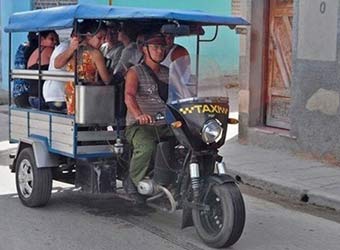Holguin to Become the Capital for Motor Tricycles for Public Transport

HAVANA TIMES — Holguin will add a new proud title to that of the “City of Parks” this month and will now also become the Capital of Motor Tricycles.
From the end of this month, the province of Holguin and its capital will become the place with the greatest number of motor tricycles in all of the country, in its search to look for affordable alternatives for the people in order to provide relief to the public transport crisis.
According to TaxiCuba company in Holguin, in charge of this special transport program, a total of 170 motor tricycles, made in China, have already been allocated to the region and will slowly arrive so they can start working under the system of leasing them out to drivers.
Mobility study
Holguin will be the province with the greatest number of these vehicles, which began to operate as public transport in Santiago de Cuba and in Trinidad, Sancti Spiritus.
“A mobility study was conducted in Holguin, which included the number of bicitaxis that are operating, as well as cars and collective taxi drivers on the main city routes and transport needs,” reported Jorge Mastrapa, the director of TaxiCuba in statements he gave to the provincial newspaper Ahora.
Mastrapa said that 12 out of the 170 motor tricycles allocated to Holguin can already be found on its streets, and 8 more should arrive next week.
The Chinese-made vehicles are assembled in Havana, with a four-stroke 260 cc (cubic centimeter) engine, a 5-speed transmission and capacity for six passengers.
Like tourism taxis
According to TaxiCuba statistics, motor tricycles can travel 13 kilometers per liter and will operate on a lease basis, the same way tourism taxis do.
The official explained that they will lease the vehicle out to taxi drivers for a daily fee, and therefore they would have to make a significant return and charge in national pesos, set at 4 regular Cuban pesos (CUP) initially for the route between Holguins provincial hospitals.
“Now, we are immersed in the personnel selection process for drivers who will drive these motor tricycles,” Mastrapa added.
National authorities, provincial and local governments are all looking for alternatives to public transport which will be more affordable to the population, in the middle of a crisis that has only worsened after imposing stiff fare regulations and requirements along the routes the collective taxi drivers operate on, especially in Havana, since the beginning of the year.






Can I buy one near Moran.
Well yes Moses, it is indeed progress. Advancing from a bici-taxi constructed with re-bar and dependent upon human pedalling power for energy, to actually having a driver with a 260 cc engine (just under 30 cc per person) is exciting. I recall visiting Santa Clara a few years ago when having visited the exhibits at the de-railed train site, we took a motorbike/bici-taxi to that awful over the top obscenely expensive memorial to Dr. Ernesto Guevara de Serna Lynch. Give me a pedalled bici-taxi any day, for we were almost shaken to bits!
The memorial itself, which as you probably know, covers several acres is memorable for two reasons. The first is that just off the edge of the massive plaza is a normal Cuban home – sheet metal, concrete blocks etc. in marked contrast, and the second was the parade of the faithful many wearing the T-shirt image of their supposed hero, quietly filing past the hole in the wall where the remains dug up from under the runway in Bolivia are stored. Guttering candles, low lights, flowers – reminiscent of a Catholic place of worship. For an avowed Marxist that really is humorous. But I guess they couldn’t reasonably put him on display like Lenin.
What turns my stomach is that there are those armchair Bolcheviks who read this post and think “how quaint”. Of course, they have no problem riding around in their 15 year-old Volvos and Subarus. But imagine if this really was your daily transport? Rain or shine, heat and humidity. After 60 years of the Castros revolution, this is progress?
So now, Cubans are to travel in unacustomed style and luxury. This is indeed progress! As it is anticipated that the GAESA subsidiary will make money, recruitment will commence with Party members. That debt with China is ever enlarging.
I note that the number of bici-taxis being converted to using electric motors is steadily increasing so the regime is getting in on the act.